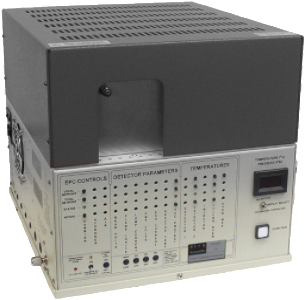Description
The Educational TCD GC system is ideal for undergraduate chemistry classes with labs. Configured on the ultra compact 310 chassis, the Educational GC includes a traditional 4 filament Thermal Conductivity Detector that can heat to 275oC. Our educational systems are for domestic customers only, and only come in a 110V configuration.
The built-in single channel PeakSimple data system provides easy and powerful data acquisition, as well as temperature programming for the column oven. The column oven is programmable to 400oC with unlimited ramps and holds, and is equipped with fast cool-down fans. Electronic Pressure Control (EPC) for the carrier gas provides rock-solid retention time reproducibility.
Because of their low cost and upgrade-ability* with other Buck detectors and injectors, these GCs are also used by thrifty labs for simple applications such as landfill gas analysis, stack monitoring, and quality control.
Thermal Conductivity Detector
- Universal detector
- Detects from 100% down to 200-500 ppm
- Easily replaceable filaments
- Thermostatted up to 275° C
Our TCD is equipped with user replaceable filaments, so it can be quickly returned to service in the event of a burn-out.
Because it detects all molecules, the Thermal Conductivity Detector is commonly used for fixed gas analysis (O2, N2, CO, CO2, H2S, NO, etc.) where the target analytes do not respond well on other, more sensitive detectors.
The TCD can detect concentrations from 100% down to around 100 ppm on a flat baseline with sharp peaks. Where the peak is broad or the baseline is not flat, detection limits of 300 ppm are more realistic. For lower detection limits, the HID detector may be more suitable for inorganics, and the FID detector provides 1ppm detection for hydrocarbon species.
The TCD consists of four tungsten-rhenium filaments in a Wheatstone bridge configuration. Electric current flows through the filaments, causing them to heat up. Carrier gas (usually helium, which has very high thermal conductivity) flows across the filaments, removing heat at a constant rate.
Two of the filaments are exposed only to carrier gas (reference), and two are exposed to the carrier/sample flow. When a sample molecule with lower thermal conductivity than the carrier gas exits the column and flows across the two sample filaments, the temperature of the filaments increases. This temperature increase unbalances the Wheatstone bridge and generates a peak as sample molecules transit through the detector.
A filament protection circuit prevents filament damage by disabling the current if carrier pressure is not detected by the GC, but cannot prevent filament damage in all circumstances.


